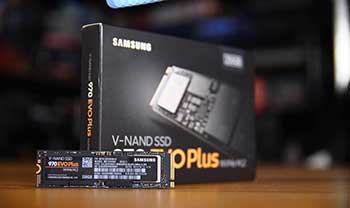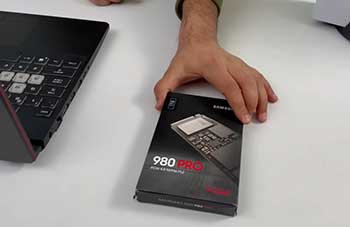For tech enthusiasts and power users looking to upgrade their PC’s storage, Samsung’s 970 EVO Plus and 980 Pro NVMe SSDs are two of the top options to consider. But with relatively close specs and pricing, which one is better?
In this detailed comparison, we’ll examine the key differences between the Samsung 970 EVO Plus and 980 Pro to help you decide which NVMe SSD is the better choice for your needs and budget.
A Brief Comparison Table
| Specs | Samsung 970 EVO Plus | Samsung 980 Pro |
| Sequential Read | Up to 3,500MB/s | Up to 7,000MB/s |
| Sequential Write | Up to 3,300MB/s | Up to 5,000MB/s |
| Endurance (TBW) | 600TB (1TB model) | 1,200TB (1TB model) |
| Max Capacity | 2TB | 1TB |
| Price | $140 (1TB) | $230 (1TB) |
| PCIe Version | PCIe 3.0 | PCIe 4.0 |
| Form Factor | M.2 2280 (single & double sided) | M.2 2280 (single sided) |
| Encryption | AES 256-bit | AES 256-bit + TCG Opal |
| Warranty | 5 years | 5 years |
Overview Of The Samsung 970 EVO Plus And 980 Pro
The Samsung 970 EVO Plus and 980 Pro are both M.2 NVMe SSDs that utilize Samsung’s cutting-edge V-NAND flash memory and a PCIe Gen 3 x4 interface.

The 970 EVO Plus is an upgraded version of the original 970 EVO, offering excellent performance for everyday computing and gaming. Key specs of the 970 EVO Plus include:
- Sequential read speeds up to 3,500MB/s
- Sequential write speeds up to 3,300MB/s
- Available capacities: 250GB to 2TB
- 5-year warranty
The 980 Pro sits above the 970 EVO Plus in Samsung’s consumer SSD lineup as their flagship NVMe drive. It’s optimized for intense workloads like 4K/8K video editing, 3D modeling, and other productivity tasks. Key specs of the 980 Pro include:
- Sequential read speeds up to 7,000MB/s
- Sequential write speeds up to 5,000MB/s
- Available capacities: 250GB to 1TB
- 5-year warranty
Also Read: Comparison Between Samsung 980 And 970 EVO Plus SSDs
Now let’s dive deeper into how the 970 EVO Plus and 980 Pro compare across several key factors:
Performance And Speed
The Samsung 980 Pro is the clear winner when it comes to raw performance, with nearly double the rated sequential read/write speeds of the 970 EVO Plus.
In real-world usage, the 980 Pro’s blazing-fast speeds are most noticeable when transferring large files like 4K videos or batch editing high-res photos. The 970 EVO Plus is no slouch, but the 980 Pro maintans a solid lead especially for write-intensive workloads.
For everyday tasks like booting Windows, launching programs, or gaming, both SSDs will feel extremely snappy and responsive. Unless you regularly work with huge file sizes, the 970 EVO Plus has plenty of performance for most users.
Endurance And Reliability

The 970 EVO Plus and 980 Pro both utilize Samsung’s reliable 3-bit MLC V-NAND flash memory. However, the 980 Pro uses a newer generation (5th gen) that further optimizes endurance and reliability.
In terms of total bytes written (TBW) over the lifespan of the drive, the 980 Pro offers up to 1,200 TBW on the 1TB model. The 970 EVO Plus is rated for 600 TBW on the 1TB model.
Real-world endurance for both drives is extremely high for typical consumer workloads. Unless you’re writing hundreds of GB per day, you’re unlikely to wear out either SSD before the 5-year warranty expires.
Overall, while the 980 Pro has the edge in rated endurance, both drives are highly reliable for everyday usage. The 970 EVO Plus offers plenty of endurance headroom for most users.
Power Efficiency
Thanks to Samsung’s refinements to the Phoenix controller and V-NAND memory, the 980 Pro offers better power efficiency over the 970 EVO Plus.
The 980 Pro has an idle power draw of just 5.4mW, compared to 6mW on the 970 EVO Plus. Under sustained workloads, the 980 Pro uses 10% less power overall based on Samsung’s specs.
This can lead to longer battery life if using the SSD in a laptop. Desktop users likely won’t notice the minor power efficiency differences during normal operation. But the 980 Pro runs cooler and requires less voltage for peak performance.
Capacity Options
One key difference is the 980 Pro’s maximum capacity is currently 1TB, while the 970 EVO Plus goes up to 2TB.
For anyone needing a single-drive capacity higher than 1TB, the 970 EVO Plus is the only option right now until Samsung releases larger 980 Pro models.
On the other end, the entry-level 250GB 980 Pro gives you an affordable way to gain some of its performance benefits in a smaller form factor. The 970 EVO Plus starts at 500GB.
Cost And Value
Based on current MSRP and street pricing, the 970 EVO Plus offers better value for money when you consider its performance versus the 980 Pro.
As of this writing, the 1TB 970 EVO Plus costs around $140 while the 1TB 980 Pro sells for around $230. Considering the relatively small performance gains for most users, the 970 EVO Plus gives you most of the 980 Pro’s speed at over $100 less.
However, the 980 Pro maintains a price premium due to its cutting-edge components and Samsung’s marketing focus on high-end workstation use cases. For professional content creators and power users the 980 Pro is likely worth the extra cost.
Casual users and gamers are better off saving some money with the 970 EVO Plus, as it still provides top-tier NVMe SSD performance at a more affordable price point.
Compatibility
The Samsung 970 EVO Plus and 980 Pro are broadly compatible with desktop PCs and laptops that have an M.2 NVMe slot on the motherboard or a PCIe adapter card. This includes most modern AMD and Intel platforms.
However, the 980 Pro requires an M.2 slot that supports PCIe 4.0 for maximum performance. On older PCIe 3.0 systems, the 980 Pro will still work but at reduced speeds comparable to the 970 EVO Plus.
So you’ll really need a newer Ryzen 3000 or 5000 series desktop processor or Intel 11th/12th gen chip that offers PCIe 4.0 lanes directly from the CPU.
The 970 EVO Plus can still provide great performance on PCIe 3.0 since it wasn’t originally designed as a PCIe 4.0 SSD.
Also Read: Is Solidigm P44 Pro Better Than 990 Pro?
Form Factor
Both the 970 EVO Plus and 980 Pro utilize the compact M.2 2280 form factor to fit directly onto a desktop motherboard or laptop’s internal M.2 slot.
Some advantages of the M.2 form factor are:
- Small physical footprint to fit various PC builds
- Direct connection to PCIe lanes for reduced latency
- Supports NVMe for increased bandwidth
- No cables required for a clean install
The only real difference is the 980 Pro uses a single-sided M.2 design, while the 970 EVO Plus requires an M.2 slot that can accommodate double-sided M.2 sticks. This shouldn’t be an issue for most modern M.2 slots.
Security Features
Samsung equipped both the 970 EVO Plus and 980 Pro with AES 256-bit hardware encryption support to help keep your data secure.
This allows you to enable full-disk encryption on these drives without a major performance hit. The AES encryption engine is directly integrated into the SSD controller.
In addition, the 980 Pro adds support for TCG Opal and IEEE 1667 standards. This allows things like password protection on the drive.
Overall, both drives offer excellent security right in the hardware. But the 980 Pro does gain a few extra enterprise-level features for business use cases requiring stricter data protection.
Included Software
To help you get the most out of your SSD, Samsung includes some optional software tools:
- Samsung Magician – Drive management utility for tasks like updating firmware, benchmarking, overprovisioning, cloning drives, and enabling encryption.
- Samsung Data Migration – Easy way to clone your old drive when migrating to a new Samsung SSD for seamless transition.
- Samsung Portable SSD – Makes your drive accessible across devices like PCs, Android, and consoles.
The core software features are very similar between both the 970 EVO Plus and 980 Pro. The Magician and Data Migration tools work reliably with both SSDs to help you optimize performance and migrate data.
Warranty And Support
One area where Samsung stands out is the 5-year limited warranty included with both the 970 EVO Plus and 980 Pro. Many competitor SSDs still only offer 3-year warranties.
This provides extra coverage should you run into issues due to defects or everyday wear and tear. Both SSDs are rated to last for at least their warranty periods under normal use.
In the event of a failure or problem, you can contact Samsung’s support team and initiate an RMA. Overall customer service is generally responsive and helpful based on other user reports.
Given the close specs and hardware of the two SSDs, you can expect a very similar warranty experience should any issues arise down the road. The 5-year coverage is a nice perk.
Also watch the video!
Frequently Asked Questions (FAQ)
For most regular users, the 970 EVO Plus provides nearly as good performance as the 980 Pro for a decent chunk less money.
The 980 Pro only makes sense for professional power users who need the absolute fastest speeds for working with huge files on a daily basis. For general use, the 970 EVO Plus is the better value.
Yes, the Samsung 980 Pro outperforms the older 970 EVO by a wide margin, with nearly 2x faster rated sequential read/write speeds.
The 980 Pro uses Samsung’s latest V-NAND technology paired with a refined controller to hit 7,000/5,000 MB/s seq. reads/writes. The 970 EVO Plus is a better comparison as the upgraded version of the 970 EVO.
The Samsung 980 Pro is better in terms of raw performance and responsiveness for demanding workloads thanks to support for PCIe 4.0.
However, for casual usage, the 970 EVO Plus gets you about 90% of the 980 Pro’s speed for a lower cost. Unless you frequently work with massive files, the 970 EVO Plus is likely the better buy for most people.
Yes, the Samsung 980 Pro is considerably faster and more advanced than the older 970 EVO due to the newer V-NAND technology and upgraded Phoenix controller.
The 980 Pro can reach speeds over 7,000 MB/s seq. read and 5,000 MB/s seq. write on a PCIe 4.0 system, while the 970 EVO is capped at around 3,500/2,500 MB/s.
Also Read: Comparison Between Zotac And Asus.
Conclusion
For intense content creation, video production, 3D modeling, and other demanding productivity tasks, the Samsung 980 Pro is the clear choice. It provides cutting-edge performance to shave precious time off large file transfers and workflows.
But for general use, gaming, and everyday multitasking, the Samsung 970 EVO Plus still delivers excellent NVMe SSD speeds and responsiveness at a more budget-friendly price point.
In the end, it comes down to your specific needs and budget. The 980 Pro is the fastest M.2 NVMe SSD Samsung offers, while the 970 EVO Plus hits the sweet spot for affordable performance. Both utilize top-tier NAND flash and Samsung SSD technology.
Hopefully this detailed comparison helps give you a clearer picture of how the Samsung 970 EVO Plus and 980 Pro stack up. Choosing the best NVMe SSD for your system gives you a simple yet impactful upgrade that you’ll notice daily.
